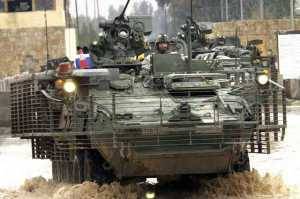
Army engineers are designing and implementing important Stryker vehicles upgrades. The efforts are focused on technologies that will provide the platform a stronger engine, improved suspension, more on-board electrical power and next-generation networking and computing technology.
The Army's more than 4,187 Stryker fleet includes 10 variants of the flat-bottom platform and an additional seven variants of the double V-hull design. The Stryker fleet continues to maintain an overall readiness availability rate of more than 96 percent in Afghanistan and throughout that region, Army officials said.
"We're taking a leap forward to bring this platform to where it will benefit the Army for years to come," said Steven Campbell, Army systems coordinator, Stryker.
Phase 1 of the Stryker ECPs, or engineering change proposal, will lead to a preliminary design review and the construction of a demonstrator vehicle sometime next summer. Phase 1 includes a series of key improvements to the platform designed to, among other things, improve the overall performance of the Stryker, computing and on-board electronics capabilities.
The thrust of Phase 1 includes an electrical power upgrade designed to replace the current Stryker's 570 amp alternator with a more powerful 910 amp alternator and an engine upgrade replacing the existing 350 horsepower engine with a stronger, 450 horsepower engine. The new engine is a commercial-off-the-shelf item.
"We're using a Caterpillar C9 engine, a mature technology already in use. We will package this to fit inside the engine compartment and provide enough cooling for it to operate effectively," said Lt. Col. Jim Schirmer, product manager, Stryker.
The Stryker ECP also includes a stronger suspension that will improve vehicle mobility at higher weights and an in-vehicle network, giving the platform a "digital backbone" able to improve data and video sharing between crew stations in the vehicle, Schirmer said.
The in-vehicle network will include a managed switch, intelligent software, display screens, and processing units, which will allow secure and reliable data-sharing between the systems on-board the vehicle. This will also reduce the size, weight, and power consumption requirements of the future systems integration of the components on the vehicle platform.
"For example, data and video from the driver's thermal viewer, odometer readings, Blue Force Tracker, One-System-Remote Video Terminals and screens which show weapons and targeting-related information will all be shared seamlessly across the various workstations," Schirmer explained. "We have already started some of the early software development for this."
The in-vehicle network approach is grounded in "open architecture," meaning that information technology systems and electronics will all be built to a common set of technical standards ensuring maximum interoperability. This set of standards, referred to as VICTORY, will enable a single computer or system to run a host of interoperable applications and functions. With the VICTORY architecture, the vehicle will be able to streamline and more easily exchange and transmit information while ensuring that the maximum number of programs and applications are possible on any given computer or display screen.
These areas of improvement for the Stryker are now being examined as part of an ongoing cost-benefit analysis slated for completion later this year.
"The Army's cost-benefit analysis will look closely at these four technology areas and determine the best way to get the most efficiency out of the dollars available to improve the platform. We want to make sure that we capture what we need to do, and do so within fiscal reality and other Army priorities," said Norman Stuckey, Army systems coordinator, Stryker.
The Strykers receiving the ECPs will be better equipped to receive a host of new networking gear already being outfitted on vehicle platforms, including Warfighter Information Network - Tactical, a mobile Satcom and radio network and a next-generation force tracking application called Joint Battle Command - Platform, among other things.
US Army
31.07.2012